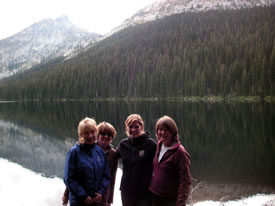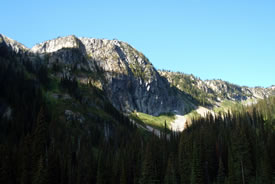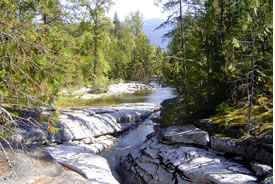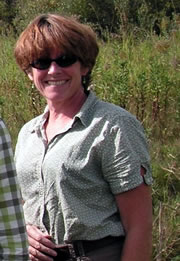Journey to Canada’s Middle Earth: My first trip to Darkwoods

Ladies of NCC's BC Region: Linda Hannah, Trish Blackstock, Hillary Page and Nancy Newhouse. (Photo by NCC)
My bonus this fall was my first trip ever to Darkwoods with the ladies of CanRock: not a rock band at all, but instead the Nature Conservancy of Canada’s (NCC’s) Canadian Rockies Program (Nancy Newhouse, Hillary Page and Regional Vice-president Linda Hannah). We spent a night in a rustic little cabin that was donated to NCC in Tye on Darkwoods.
Maybe it was the excitement of getting out of the office, the thought of adventure and all that fresh air but nothing seemed to dampen our spirits, even though it was raining.
Entering Darkwoods is not for the faint of heart or unseasoned backcountry traveller. There is a labyrinth of roads for testing map-reading skills. Seeking hidden markers and making essential radio check-in calls — “five up Jersey for two” — are a must! But having the talents of our local expert Dave Wickstrom, NCC’s South Selkirk program manager based out of Nelson, to guide us through the passes is a treat.

Laib Creek Headwaters, Darkwoods, BC (Photo by NCC)
Dave is a real wizard at these roads and a master of storytelling. I listen spellbound as the kilometres tick by and he shares Darkwoods’ magical stories: fires and fire breaks, climbers and peaks, miners and jewels, lakes, streams, fish, forests and wildlife. It’s like stepping onto the set of Lord of the Rings, the stories woven from the landscape and told with such warmth and respect by this seasoned storyteller.
Our first stop: Creston, with its views of Darkwoods’ southern boundaries and mountains rising above the Creston Valley Wildlife Management Area and Kootenay Lake. Then, on to Devils Hole, which is nothing like Hell’s Gate or entering Mordor at all. Rather, it’s a small lake on the map that seems to attract families seeking permits to Darkwoods. I wanted to see what drew them to this lake and I wasn’t disappointed. Devils Hole is an alpine lake with crystal clear water, beckoning foreshores and peaked walls. I suspect this is one of many beautiful lakes in Darkwoods, but why its demonic name? Perhaps its part of another story!
Reluctantly we leave the lake as dusk is falling. Then, on to our destination at Tye, with every turn in the road offering up a new vista. And then, we arrive — Tye! How to describe a small settlement that speaks of past railway, mining and forestry camps that is now a haven for families from local communities? Walking among the curious-looking buildings I can almost hear the children’s laughter, the hive of activity in hobbit town and the stories shared around campfires. We sit by a campfire ourselves that night and enjoy the freedom and privilege of being at Darkwoods, listening awhile to the elk chuckling from the safety of the dark.
Morning brings no room service but good coffee, laughter and rain.
We visit the spectacular Cultus Creek, watching the waters that tumble and cascade from pool to pool. The strength and power in full flood must be terrifying, yet electrifying, as wind storms uproot trees and a turbulent Kootenay lake pounds the shoreline. How easy it could be to be cut from the rest of the world.

Cultus Creek, Darkwoods, BC (Photo by NCC)
Our storyteller this morning takes us to hidden treasure: 600-year-old cedars. I almost have to run to keep up with his sureness of foot in the undergrowth. The colour in the forest is changing. Fall is here but still a myriad of mysterious mushrooms — some purple, some orange — carpet the forest floor.
Although the light is thin today and we drift in and out of mountain mist the forest never seems threatening or dark. So why “Darkwoods”? I ponder on this — perhaps it’s a joke played upon many to keep them out of this beautiful place.
Perhaps I understand how many want to keep this place quiet, undiscovered. Darkwoods is a home for so many species — flora, fauna and humans — all trying to coexist and flourish. It offers a delicate balance of all things that exist in one breath. Perhaps that is the magic or essence of Darkwoods — a place to coexist.
We leave, and I know I will come back and see more, explore more.


